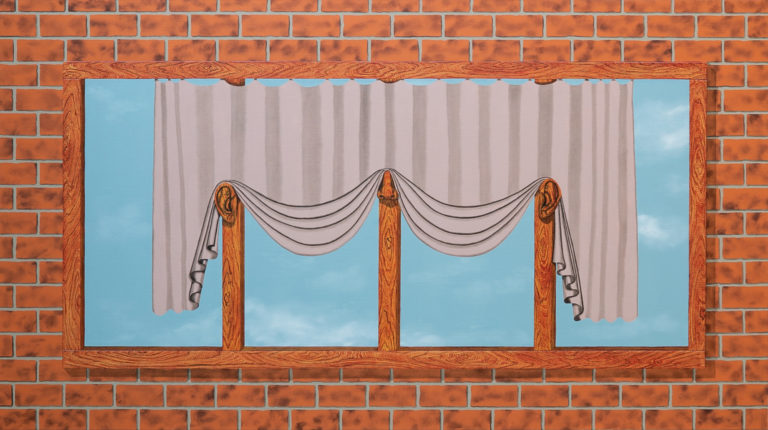Exhibition leaflet
Sarah Margnetti. Supportive Structures
(Manor Art Prize 2022 Vaud)
Description
With a sure mastery of the trompe-l’œil technique, Sarah Margnetti has developed a pictorial style that combines optical illusion and abstract forms. Deployed in monumental wall paintings or on canvas, these motifs represent body parts whose functions are often reap- propriated (an ear, for instance, becomes an entire body, a body a brain, and entwined fingers a kind of fence or grating) or worked out in multiple variations. They spring from or melt into elements of the archi- tecture or setting drawn from the world of the theater (curtains, balustrades, theater seats, etc.) in a play of inside and out, dream and reality. Among the sensory organs, the ear is a recurring motif. It merges with the knots in the wood of a trompe-l’œil setting, is transformed into an artist’s palette, or replaces the eyes in a face. The artist’s work then seems to emphasize listening over speech and vision, playing with and undermining art history’s traditional motifs, notably that of the female body.
For her solo exhibition in the Espace Projet, Sarah Margnetti has mounted a selection of artworks especially created for the show, along with wall paintings done on site that borrow from, extend, or revisit elements that are central to her body of work. On the glass façade, the artist plays with a curtain motif. Like glass, the curtain is that element which both separates and connects inside and out. While curtains indeed obstruct our view, they also allow us to feel, hear, even touch what is found directly behind them, whereas glass makes it possible to connect visually what it physically separates. All of Sarah Margnetti’s work focuses on porosity, passage, and the inter- mediary, the in-between state, whether in architectural designs and their decors (curtains, brick walls, holes in the wood), or in the body and its sensory organs (nose, mouth, ear). Bodies and archi- tecture are joined and fused – a knot in a piece of wood assumes the shape of an ear, an ear becomes the capital of a column, and a column sprouts arms, while the veins of painted marble conjure up skin.
Originating in her interest in the link between the body and architecture, a recurring element in the artist’s repertoire of visual tropes is the figure of the caryatid. In ancient Greece, the caryatid (literally “maidens of Karyai,” a town in the Peloponnese) was a sculpted female figure often draped in a long tunic; supporting an entablature on her head, the caryatid often took the place of a column or pillar in buildings.
By reappropriating this figure, Sarah Margnetti interrogates the histo- rical fusion of female bodies and architecture. She uses the caryatid to lend visual form to the question of the invisible effort put in by women to uphold the stability of the economic and social edifice of our world.
Indeed, as Camilla Paolino writes in a fine essay published in the cata- logue accompanying the present exhibition, “the caryatid’s functio- nality depends on her ability to do as if the feat of carrying the weight of the system were effortless, that is, on her capacity to keep the labor she performs concealed: an unfathomable, unthinkable arcane. In order to preserve the arcane, the caryatid must remain still and silent. If she speaks, the building trembles. If she makes a move, the building collapses […] However, Sarah Margnetti’s caryatids are not only a tribute to women’s disregarded labors. They are also meant to address the work deployed to support the world of art and culture, which thrives on the unrecognized labor of populous ranks of invi- sible workers.”
Biography
Sarah Margnetti holds a Bachelor of Arts degree in Visual Arts from the École cantonale d’art of Lausanne / ECAL (2005-2009) and a Master’s in Visual Arts HES-SO, Work.Master from the Geneva University of Art and Design / HEAD (2013 – 2015). She also completed a practical training course at the Institut Van der Kelen-Logelain in Brussels, one of the first schools devoted to the study of decorative painting. She
is the recipient of the Manor Art Prize Vaud (2022) and a Swiss Art Award (2018). Her work has been exhibited in a range of institutions and venues, including Le Commun, Geneva; CAN, Neuchâtel; La Villa du Parc, Annemasse; Last Tango, Zurich; SALTS, Basel; and Stems Gallery, Brussels.
